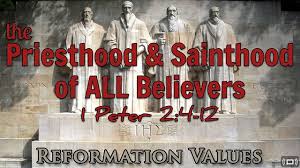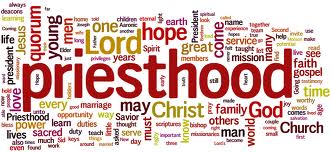 The Priesthood of Believers Includes All Who Believe In Jesus
The Priesthood of Believers Includes All Who Believe In Jesus
- Revivals always start in the soil that has been prepared by God, at the grass roots level.
- Revival never flourishes in institutional structures, but eventually affects those structures.
- Revival is usually a threat to institutional structures, thus they oppose true revivals.
- Revival is birthed out of the belief that all believers in Jesus Christ are part of the ”Royal Priesthood” defined in I Peter. It is a priesthood of peer relationships of “acceptance” and “equality” through brotherhood and bonding through the Holy Spirit. It is a fluid organism, not a rigid organization.
- Revival transcends religious institutional positions and offices and touches individual believers’ lives individually and in masses.
- Revival is in the control of the Holy Spirit, but the institutional church will fight for that control.
- Revival can touch you, a believer in Christ, if you are open and accepting of the Holy Spirit of Jesus Christ.
Since the Great Reformation, lead by Martin Luther, the doctrine of the Priesthood of Believers surfaces during a season of revival, because revival touches individual believers and the masses. Revival works in the hearts and spirits of individuals that touches the corporate good. Individual believers in Jesus Christ begin to recognize who they are in Jesus Christ through the teachings of the Holy Spirit. This exposure of recognizing one’s position in Christ, forever changes how an individual believer in Jesus Christ thinks, acts, and what motivates him.
The need for a priesthood in the Jewish faith is archaic because there is no Temple, temple worship, or animal sacrificing any more. God created a priesthood to have humans He could draw near and who would draw near to him. There is still that need, and the Priesthood modeled by Abraham through Melchizidek before the Mosaic priesthood ever existed is an example of one. This priesthood became a New Testament “Royal Priesthood” under the High Priest, Jesus Christ.
This priesthood operated effectively in the first century because believers were “equal peers” in the faith. There was no hierarchy of church government, but Christianity was built on the bonding of relationships with their God and with each other. At first Christianity was known as the only religion that did not have a building, a temple, a spiritual institution where they formally met. Believers claimed their bodies to be “the temple of the Holy Spirit”, thus no need for a physically built building. When the Temple in Jerusalem fell to foreign invaders, Christianity remained, even grew. Although historically rooted in Judahism and Temple worship, they could survive, grow, and flourish without a physical building. Revival spread.
 Today, in America, aging Temples, alias Christian religious structures, are in almost every city block, dotting the rural countryside, and are even called “churches”, and we as “the Church” have lost focus on the people being the Church, not the building nor institution nor the hierarchy. The Church was birthed without buildings and a hierarchy, and can survive, revive, and grow without them, but it can’t grow without a priesthood of believers.
Today, in America, aging Temples, alias Christian religious structures, are in almost every city block, dotting the rural countryside, and are even called “churches”, and we as “the Church” have lost focus on the people being the Church, not the building nor institution nor the hierarchy. The Church was birthed without buildings and a hierarchy, and can survive, revive, and grow without them, but it can’t grow without a priesthood of believers.
I firmly believe if the five fold is to be the next wave of revival for the Church, it must be grounded in the doctrine of the Priesthood of Believers, where every believer in Jesus Christ is an equal peer that serves one another sacrificially and is willing to lay down their life for their brethren. It is a daunting challenge, but an attainable one in Jesus.